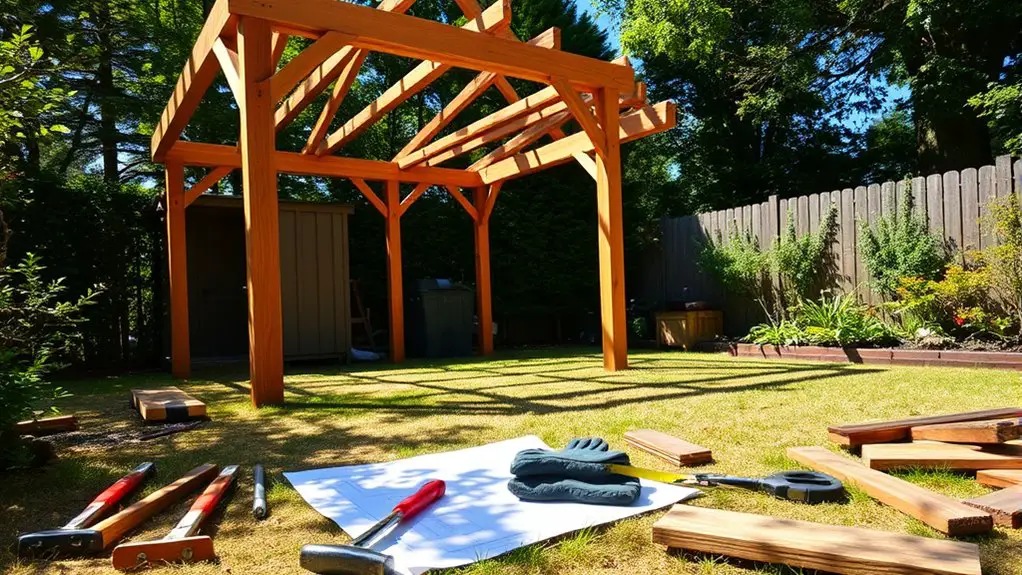To build a DIY gazebo, start by planning your design, considering size, location, and style. Gather materials like cedar or pressure-treated lumber, screws, and tools such as a saw and level. Prepare the site by leveling the ground and ensuring proper drainage. Construct the frame by laying down a sturdy base, erecting posts, and connecting beams. Finally, add finishing touches like lighting and comfortable furniture to enhance the space. Keep going to discover more detailed steps and creative ideas.
Planning Your Gazebo Design
When planning your gazebo design, it is essential to take into account at least three key factors: location, size, and style. Your location determines sunlight, shade, and wind exposure, influencing the overall comfort. Consider the size based on your intended use—will it host family gatherings or serve as a quiet retreat? Next, explore various style options, from classic Victorian to modern minimalist. Each choice reflects your personal aesthetic and should harmonize with your landscape. Design considerations also include materials that align with your vision, ensuring durability and low maintenance. By thoughtfully evaluating these elements, you’ll create a gazebo that not only enhances your outdoor space but also offers a true sense of freedom in your lifestyle. Additionally, the surrounding landscape should complement natural beauty, enhancing the overall aesthetic of your gazebo.
Gathering Materials and Tools
To successfully build your gazebo, you’ll need to gather a variety of materials and tools that will guarantee the project runs smoothly. Focus on material selection to ensure durability and aesthetics—consider wood types like cedar or pressure-treated lumber. Additionally, it’s essential to choose materials that align with your desired gazebo styles, as this will influence both functionality and visual appeal.
Here’s a handy table to help you with your choices:
| Material/Tool | Purpose |
|---|---|
| Lumber | Structure and framework |
| Screws/Nails | Assembly |
| Hammer | Driving nails |
| Level | Ensuring even surfaces |
| Saw | Cutting materials to size |
With the right tool types, including a drill and measuring tape, you’ll be fully equipped to begin this fulfilling journey to create your very own outdoor retreat.
Preparing the Site
Before you immerse yourself in the construction of your gazebo, it is essential to prepare the site properly, as this foundation sets the stage for a stable and durable structure. Start with a thorough soil assessment to determine its composition and drainage capabilities. This step guarantees that the ground can support your gazebo over time. Next, focus on site leveling; you want a flat area free from debris or vegetation. Use stakes and string to mark the perimeter, checking for evenness with a level. If necessary, excavate or add soil to achieve the desired grade. By investing time in these preparations, you’ll create a solid base that allows your gazebo to flourish, embracing the freedom of outdoor living. Additionally, ensuring proper drainage is crucial to prevent water damage and to extend the lifespan of your gazebo.
Constructing the Gazebo Frame
As you immerse yourself in constructing the gazebo frame, it is crucial to guarantee that your measurements are precise to create a sturdy structure. Start by selecting the appropriate frame types, such as a square, rectangular, or octagonal design, based on your vision and space. Lay out the base with treated lumber, ensuring it’s level and square. For assembly techniques, use galvanized screws and brackets to secure connections, which will enhance durability. As you erect the vertical posts, double-check their plumb alignment before fastening. Connect the top beams, forming a rigid skeleton that’ll support your gazebo’s roof. Remember, each component you install contributes to the overall integrity, so take your time and enjoy the creative freedom of building your unique retreat. Additionally, be sure to secure the gazebo to the ground to prevent tipping or damage from winds.
Finishing Touches and Decoration
Once you’ve completed the structural elements of your gazebo, you can turn your attention to the finishing touches and decoration that truly bring the space to life. To enhance your gazebo’s functionality and aesthetic appeal, consider these key elements:
- Lighting Options: Install string lights or lanterns to create a warm, inviting atmosphere during evening gatherings. Consider using energy-efficient designs to save on electricity bills while enjoying your outdoor space.
- Outdoor Furniture: Choose comfortable seating and tables that match your style, allowing for relaxation or entertaining.
- Decorative Accents: Incorporate planters or hanging plants to add color and vibrancy to your space.
- Textiles: Use outdoor rugs and cushions to soften the environment, making it cozy and inviting.
Frequently Asked Questions
How Long Will It Take to Build the Gazebo?
The construction timeline for your gazebo depends on its size and complexity. Typically, you’re looking at a project duration of one to three weekends, allowing for proper planning and materials gathering. Enjoy the process!
Do I Need a Permit for My Gazebo?
Before you revel in your gazebo dreams, check your local regulations; you might find the permitting process more complicated than assembling IKEA furniture. Getting a permit can save you from potential legal headaches later on.
Can I Build a Gazebo on a Slope?
You can build a gazebo on a slope, but you’ll need to take slope considerations carefully. Proper foundation options, like post anchors or retaining walls, guarantee stability and safety while maximizing your outdoor freedom.
What Maintenance Is Required for My Gazebo?
Your gazebo needs regular maintenance for longevity. Clean it periodically to prevent mold and mildew, and apply wood treatment annually to protect against weathering. This guarantees a beautiful, functional space for your outdoor freedom.
How Can I Ensure My Gazebo Is Safe?
Isn’t it comforting to know your gazebo’s safe? To guarantee that, use quality safety materials and regularly inspect for wear. Check joints for structural integrity, reinforcing where needed, and enjoy peace of mind in your outdoor haven.

